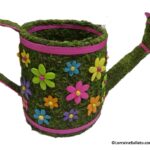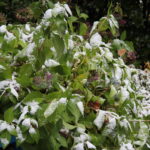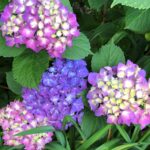This is the time of year to be alert to deer damage on hydrangeas. The winter weather pattern of deep cold, snow, and ice storms has made it increasingly difficult for them to get around and find food sources to sustain life. Deer tracks are the obvious tip off so here’s what to look for.

Deer tracks in snow
WHAT TO LOOK FOR WHEN YOU DON’T SEE TRACKS
If you don’t see tracks, be on the lookout for their scat. The tiny pellets will sometimes give them away before you notice their tracks.
Deer scat can be mistaken for rabbit pellets which are something else you also may need to handle. Both deer and rabbits spell potential danger for your plants.

Rabbit scat can be mistaken for deer scat
PREVENTING DEER DAMAGE WITH MILORGANITE
Of course, the sub-freezing temps make it impossible to use any repellent sprays. In that case, I resort to using organic Milorganite to protect my plants from deer.
It’s a granular product that deer don’t seem to like. My own experience and that of other gardeners in cold climates supports its effectiveness. Of course, all deer herds are different so this may not work for you. But I would try it before discounting its effectiveness. One of its best features is that it breaks down into fertilizer which your plants will love.

Milorganite has been known to repel deer
RABBIT DAMAGE ON HYDRANGEA
Let’s talk about the other varmint that roams freely and does damage to your hydrangeas: rabbits. They can eat your plant down to the ground in a very short time. Again, you may see their pellets before you see their tracks so be watchful. When it comes to rabbits, I have resorted to exclusion practices: covering plants with nursery pots or some kind of fencing.

Use a nursery pot to protect plants from wildlife in winter.
DEER DAMAGE AND REPELLENT SPRAYS IN WINTER
Be aware that your best deer defense is to rotate products from time to time. Deer get accustomed to what you do and will eventually breach your protection.
I’d like to believe that Mother Nature is celebrating our winter solstice with a gift of warm temps. The solstice arrives at 11:19 p.m. today, and tomorrow through next Thursday the temps are forecasted to be above freezing with no precipitation. Those are the right conditions to go out and use your favorite repellent spray on your plants. If you can’t get to it this week, keep your eyes open for another window of opportunity when the temps are forecasted to rise again. Grab those opportunities to use repellent sprays whenever possible.
CELEBRATE THE WINTER SOLSTICE
In the meantime, have your own celebration of the winter solstice. It marks the shortest day of the year when the earth’s axis is tilted farthest away from the sun. As that angle starts to shift closer, our days ever so slowly start to lengthen. By about February 1, you will notice earlier sunrises and later sunsets.

Happy Winter Solstice
A PERSONAL NOTE
I hope I helped you have a success in 2019 growing your hydrangeas. Thanks to you and many others, my BOOK reached Amazon Best Seller status and it is now selling well internationally.
I look forward to sharing a lot of info with you in the new year about new plants and old, and better ways to grow them. So enjoy this time off to dream about your garden and watch for my updates in 2020. Happy New Year!
6 Secrets for Stunning Hydrangea Flowers
Get my FREE mini-guide with 6 fool-proof tips showing how to grow hydrangeas that produce the most amazing flowers.
No spam - I promise!




